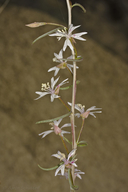notes This is the white-flowered form of Clarkia xantiana ssp. parviflora which also occurs in a pink-flowered form. The nominate subspecies C. xantiana ssp. xantiana is pink-flowered. It's interesting that in contrast to the nominate subspecies, which is considered mostly an out-crosser, subspecies parviflora is considered to be mostly self-pollinated...and has a number of characters associated with that syndrome. For instance, C. x. ssp. parviflora is typically:
1) smaller-flowered than C. x. ssp. xantiana; 2) has stigma maturing while the anthers are still shedding pollen (vs. the strictly protandrous dichogamy...where stigmas become receptive only after anthers are spent...that is found in the nominate ssp.); and 3) has the stigma at maturity held at more-or-less the same height as the anthers (vs. significantly higher & well-separated in ssp. xantiana...AKA 'herkogamy').
C. x. ssp. parviflora also has a generally more arid & easterly distribution than the nominate ssp., as is the case with the plant seen in the photos here.
See the paper Eckhart & Geber(1999) for more on distinctions between the subspecies. And note that the location here is not far from the location described in this voucher by Eckhart & Geber which includes the comments: ''Petals white. Stigmas not beyond anthers. Very little (or no) protandry''...which holds for my photos as well.
More details can be found in the papers Moore & Lewis(1964) (entitled 'The evolution of self-pollination in Clarkia xantiana') and Lewis & Raven(1992).
Postscript (6/12/22): Some additional references... Anderson, J.T., V.M. Eckhart, & M.A. Gebe (2015). Experimental studies of adaptation in Clarkia xantiana. III. Phenotypic selection across a subspecies border. Evolution 69(9):2249-61. [Full Text]
Geber, M.A. & V.M. Eckhart (2005). Experimental studies of adaptation in Clarkia xantiana. II. Fitness variation across a subspecies border. Evolution 59(3):521 531. [Full Text]
Eckhart, V.M., M.A. Geber, & C.M. McGuire (2004). Experimental studies of adaptation in Clarkia xantiana. I. Sources of trait variation across a subspecies border. Evolution 58(1):59-70. [Full Text]
Moeller, D. A. and M. A. Geber. 2005. Ecological context of the evolution of self-pollination in Clarkia xantiana: Population size, plant communities, and reproductive assurance. Evolution 59(4):786-799. [Full Text]
Fausto, J., Eckhart, V.M., & Geber, M.A. (2001). Reproductive assurance and the evolutionary ecology of self-pollination in Clarkia xantiana (Onagraceae). American Journal of Botany, 88(10):1794-800. [Full Text]
Runions, C.J., & M.A. Geber (2000). Evolution of the self-pollinating flower in Clarkia xantiana (Onagraceae). I. Size and development of floral organs. American Journal of Botany 87(10):1439-1451. [Full Text]

